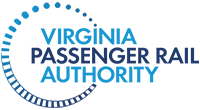WHAT IS THE FRANCONIA-SPRINGFIELD BYPASS PROJECT?
The Franconia-Springfield Bypass, located just south of the Franconia-Springfield VRE Station, is a proposed rail bridge that will allow passenger trains to cross over the existing CSXT freight tracks to serve passenger station platforms located on the east side of the tracks south of the bridge and on the west side of the tracks north of the bridge. With the Bypass, passenger trains will be separated and able to cross over the main tracks without interfering with trains on the main tracks, which will remove a major bottleneck for freight and passenger trains. The project entails building a single track on the Bypass bridge with accommodations for a future second track.
Franconia-Springfield Bypass Project
HOW WILL THE BYPASS PROJECT BENEFIT ME AND MY COMMUNITY?
The Bypass will remove an existing bottleneck in the rail corridor south of the Franconia- Springfield VRE Station. Once the bottleneck is removed, reliability of both Amtrak and VRE passenger service will be improved. Freight train movements will also be improved, resulting in less train idling time.
WHAT OTHER ALTERNATIVES WERE CONSIDERED?
During the project planning and design processes, various structure types and heights were considered. However, it was determined that conventional at-grade crossovers and interlockings would be unable to safely provide the desired movements between the freight and passenger trains. As a result, the concept for an elevated Bypass structure was developed in early 2023. This flyover structure will be the second of its kind in the United States.
WHAT WILL THE ELEVATED BRIDGE STRUCTURE LOOK LIKE?
Generalized renderings of the elevated structure are presented in the Franconia Third Track Categorical Exclusion document and can be found on VPRA’s website. The renderings depict a structure that starts and ends with a raised earthen embankment supported by retaining walls. Between the two approach embankments, a multiple-span bridge structure will be utilized. The bridge spans consist of multiple steel beams/girders and either a steel or concrete deck that will support the track itself. The bridge type was designed to lessen the height of the structure, minimizing its visual impact. The bypass structure will be approximately one mile in length.
WILL TRAINS TRAVELING ON THE ELEVATED STRUCTURE CAUSE INCREASED NOISE OR VIBRATION LEVELS AT NEARBY RESIDENCES?
A noise and vibration assessment was completed in accordance with the Federal Transit Administration’s (FTA) “Transit Noise and Vibration Impact Assessment” manual. This assessment indicated that upon completion of the project, noise levels at the nearest residences would not exceed the federal guideline of 66 decibels (dBA), or roughly the sound of a conversation or air conditioner. There will be no additional noise analysis evaluated as a part of this project.
Potential increases in vibration were identified for three residential properties west of the proposed structure in the Loisdale Estates community. The vibration analysis will be re- evaluated after completion of the 60% design. See Question 18 for information on how to stay connected and follow the project as it progresses.
HOW IS THE FRANCONIA-SPRINGFIELD BYPASS BEING FUNDED?
The Bypass is being funded through the collaboration of federal, state, and local contributions. VPRA, Amtrak, and the Northern Virginia Transportation Authority (NVTA) have each committed funding for various phases of the project.
Construction
WHEN IS CONSTRUCTION EXPECTED TO OCCUR, AND HOW LONG WILL IT TAKE TO COMPLETE THE PROJECTS?
The construction of these projects will be advanced on similar schedules, which is estimated to begin in 2024 and end in 2027 pending advancement toward final design. VPRA will have more information on this topic at the final design phase, expected in Summer 2024.
WILL THERE BE NIGHT OR WEEKEND WORK?
Weekly work schedules will be determined as the projects advance closer to the start of construction. VPRA will have more information on this topic at the final design phase, expect in Summer 2024. Please see Question 18 for information on how to stay connected and follow the project as it progresses.
HOW WILL THESE PROJECTS IMPACT TRAFFIC, PROPERTY ACCESS, AND EMERGENCY SERVICES DURING CONSTRUCTION?
Construction access routes will be determined the projects advance closer to the start of construction and a contractor is selected. We anticipate having further detail on this topic at the final design stage, expected in Summer 2024.
Residents and emergency personnel will be notified in advance of any roadway closures or detours. Passenger rail service is expected to be maintained throughout construction, and any service adjustments will be communicated by passenger rail service providers (i.e., Amtrak and VRE). Community members and emergency personnel will be able to access amenities and places of work via dedicated detour routes if necessary.
Movement of construction vehicles and transport of construction materials will occur on local roadways and is not anticipated to cause any type of major disruption.
Environmental Concerns
WILL THESE PROJECTS HAVE AN IMPACT ON THE ENVIRONMENT?
VPRA is working with the U.S. Army Corp of Engineers, U.S. Fish and Wildlife Service, Virginia Department of Environmental Quality, and other regulatory agencies to assess environmental impacts. There are currently no known significant adverse environmental impacts in the project areas. VPRA will obtain the appropriate permits before performing any work and will minimize disturbance to the surrounding areas where feasible. All land use temporarily affected by construction activities will be returned to its original use after construction is complete.
WHAT MITIGATION EFFORTS ARE IN PLACE TO REDUCE ENVIRONMENTAL IMPACTS?
VPRA will make every effort to avoid and minimize the environmental impacts of the rail improvement projects. Where impacts cannot be avoided, VPRA will apply appropriate mitigation measures as required by local, state, and federal regulatory agencies. VPRA will take steps to mitigate environmental impacts, including, but not limited to, the following:
- Wetland and stream impacts
- Floodplain impacts
- Noise and vibration impacts
- Air quality impacts

